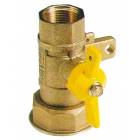Reliability of metering valves
Hydraulic fittings such as valves for meters are relatively simple tools but with high efficiency and safety

Metering valves for hydraulic connections are among the most often used and their purpose is to allow proper transmission of liquids or gaseous flow between the source of accumulation, such as a tank or a unit for water or gas, and the end user. While being geometrically similar to each other, metering valves can differ in levels of components and materials because between water and gas there exist operating conditions that can also be totally disparate. In fact, when it comes to gas, metering valves may have to endure higher pressure gradients compared to valves inside which water flows.
Inside metering valves there is a butterfly valve connected to an external knob that, by means of the operator’s manual movement, can stop or open the circuit allowing the passage of fluid. Also this component can be different depending on whether it’s metering valve for gas or water. A butterfly valve is usually in steel, a very durable material able to withstand high stresses, also in case of arrest with fluid in motion at high speed. The sphere that encloses metering valves is designed using brass, copper and zinc alloy lighter than steel but with very good mechanical and anti-corrosive properties.
The outer surface of material is not machined in order to ensure high corrosion resistance, also because the brass already departing presents these requirements.
Inside metering valves there is a butterfly valve connected to an external knob that, by means of the operator’s manual movement, can stop or open the circuit allowing the passage of fluid. Also this component can be different depending on whether it’s metering valve for gas or water. A butterfly valve is usually in steel, a very durable material able to withstand high stresses, also in case of arrest with fluid in motion at high speed. The sphere that encloses metering valves is designed using brass, copper and zinc alloy lighter than steel but with very good mechanical and anti-corrosive properties.
The outer surface of material is not machined in order to ensure high corrosion resistance, also because the brass already departing presents these requirements.
15/05/2013
I contenuti di questo sito non hanno carattere di periodicità e non rappresentano 'prodotto editoriale'.








